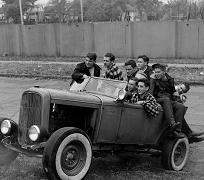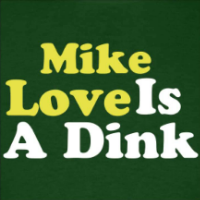#1 2015-04-28 08:33:22
- Worried Man
- Member

- From: Davebrubeckistan
- Posts: 15988
The Face of Men's Fashion in 2045?
So, where do you see the state of men's dress in the next 30 years, as we approach the middle of the 21st century? I realize this is a broad question, and I for one really have no clue.
But what have you? Let's speculate.
"We close our sto' at a reasonable hour because we figure anybody who would want one of our suits has got time to stroll over here in the daytime." - VP of George Muse Clothing, Atlanta, 1955
#2 2015-04-28 11:35:03
- Bop
- Member

- Posts: 7661
Re: The Face of Men's Fashion in 2045?
Very much the same I think WM unless we have some big technological break thrus with new fangled materials or transportation..every generation has been influenced by the past so I still think a sense of tradition may still run through it all...
Sport seems to drive fashion more than music nowadays...Surgical appliance etc seem to be the ones bringing new street fashions to the masses..and women in weird yoga leggings will be the new formal dress for weddings and other functions
Last edited by Bop (2015-04-28 11:35:50)
#3 2015-04-28 14:26:29
- Worried Man
- Member

- From: Davebrubeckistan
- Posts: 15988
Re: The Face of Men's Fashion in 2045?
I don't know man.... I foresee a vast homogenization, wherein it's like The Man in the Gray Flannel Suit all over again, but all the men have lumberjack beards and exaggerated pompadours.
"We close our sto' at a reasonable hour because we figure anybody who would want one of our suits has got time to stroll over here in the daytime." - VP of George Muse Clothing, Atlanta, 1955
#5 2015-04-28 15:43:15
- Harry08
- Member
- Posts: 429
Re: The Face of Men's Fashion in 2045?
Last edited by Harry08 (2015-04-28 15:46:29)
#6 2015-04-28 17:08:50
- Worried Man
- Member

- From: Davebrubeckistan
- Posts: 15988
Re: The Face of Men's Fashion in 2045?
^
And a decent rise at that!
"We close our sto' at a reasonable hour because we figure anybody who would want one of our suits has got time to stroll over here in the daytime." - VP of George Muse Clothing, Atlanta, 1955
#7 2015-04-28 19:11:34
- chatsworth osborne jr.
- Member

- Posts: 738
Re: The Face of Men's Fashion in 2045?
The movie Idiocracy has already showed us that we will have dispensers full of semi-disposable clothing. Think of the free t-shirt devolved into something with less cotton and more advertising. That's it. There will be no fashion as that reeks of effort and pretense. All will voluntarily adopt the throwaway billboard clothes. Hey, everybody's doing it and the price is right.
#8 2015-04-28 20:49:32
- Film Noir Buff
- Dandy Nightmare

- From: Devil's Island
- Posts: 9345
Re: The Face of Men's Fashion in 2045?
The suit will endure, modified constantly. I think as Anne Hollander said, the suit is a new garment and it is quite versatile; capable of severe modification.
It will also settle into local modifications and that means it will have a general look and many specific looks. If you interact with people all over the world, your suit will look differently than if you exist in one place all the time. Probably not different than before but the details will constantly change.
At the moment, the suit is all about individualistic expression and also what constitutes a suit vs. a sports jacket has become quite blended. Sometimes when I see someone on TV wearing something that I think would be a suit turns out to be a sports jacket and sometimes when I think the reverse, it's a suit.
The big loser at the moment may be shirts which have become plainer because suit patterns have so much more expression. However, plain colored shirts have changed and are now textured or jacquard-ed in ways that keep pace with underlying patterns or textures in suit cloths.
Shoes have likewise become an area of individual expression with styles and colors which were unthinkable a few years ago diversifying in mind numbing ways. I myself am waiting for a pair of blue calf and charcoal suede wingtips; something that goes with the very "blue" age we live in for mens suit and jacket colors.
#9 2015-04-29 02:52:52
- Bop
- Member

- Posts: 7661
Re: The Face of Men's Fashion in 2045?
Im not sure who doctored what I wrote, but.... I cant think of many if any music sub cultures of the last 5 to 10 years that have really laid down a bigger influences on popular fashion..than sportswear lifestyles more than subcultures seem to be the dominanting factor..and in these areas of exercise and leisurewear seem to have the biggest leaps in use of colour, design and technological fabric/materials being used..I thought that was pretty evident to most? But maybe its a London thing
#10 2015-04-29 12:33:12
- Goodyear welt
- Ivyist At Large

- Posts: 3089
Re: The Face of Men's Fashion in 2045?
I think jeans will be big and trainers very popular. I also think, as mad as it sounds now, that men will be wearing socks with dress shoes. I also predict that casual shirts will be worn with one full sleeve and one short sleeve. The chaps on TI will be claiming this has its roots in 1950s Ivy because these shirts will have a BD collar.
Rocking traditional, current and classic Italian Ivy since 2011.
#11 2015-04-29 13:22:15
- Worried Man
- Member

- From: Davebrubeckistan
- Posts: 15988
Re: The Face of Men's Fashion in 2045?
hahaha
"We close our sto' at a reasonable hour because we figure anybody who would want one of our suits has got time to stroll over here in the daytime." - VP of George Muse Clothing, Atlanta, 1955
#12 2015-04-30 02:35:52
- 4F Hepcat
- THE Cat

- Posts: 14333
Re: The Face of Men's Fashion in 2045?
Will the tie go the same way as the hat I wonder? It's not far off being discarded anyway.
Also think the cache of vintage items and the provenance of these will increase, even more so than they are now.
Suit cloth will continue to become thinner in response to perceived global warming and the continued over heating of public transport, offices and homes in winter. Unless of course, the mini-ice age hits and this trend will reverse.
https://www.youtube.com/watch?v=dzBS7bGJaDA
Vibe-Rations in Spectra-Sonic-Sound
#16 2015-04-30 05:28:59
- doghouse
- Member

- Posts: 5147
Re: The Face of Men's Fashion in 2045?
Hide thy infants, hide thy Lady, and hide thy husband, alas they art forcing sexual intercourse upon the entire populace. - Wm Shakespeare
#17 2015-04-30 09:43:09
- 4F Hepcat
- THE Cat

- Posts: 14333
Re: The Face of Men's Fashion in 2045?
Yes, but trying to tell our current crop of politicians this!
Vibe-Rations in Spectra-Sonic-Sound
#18 2015-04-30 09:45:23
- Chet
- Member

- Posts: 1585
Re: The Face of Men's Fashion in 2045?
Do you know what a Palmist once said to me? She said: will you let go!
Vivian Stanshall
#19 2015-04-30 09:57:01
- 4F Hepcat
- THE Cat

- Posts: 14333
Re: The Face of Men's Fashion in 2045?
Between the yoof, SNP, baby boomer and Tower Hamlets vote, I'm very glad I'm out of it!
A very undignified affair.
Vibe-Rations in Spectra-Sonic-Sound
#22 2015-05-03 23:30:04
- katon
- Member

- Posts: 363
Re: The Face of Men's Fashion in 2045?
Clothes that are considered formal now will mostly be worn for specific occasions instead of for daily life, or by groups who have adopted them as a statement, like the old-fashioned clothes worn by certain Jewish groups today. Everything else will receive a corresponding bump in formality; the business casual of today will be the business formal of 2045. For general wear, that will mean things like collared shirts and heeled shoes will become less common. Europe and Asia will move more slowly than America with this, and the East Coast will move more slowly than the West Coast. This assumes no major war or other catastrophe shifts world fashion trends. ![]() Truly casual wear will be a mash-up of several dozen fads, some stupid, some less so, just like today, and after a few years, the ones that have some fundamental appeal will get pulled into the circuit and perhaps eventually make their own way towards formality.
Truly casual wear will be a mash-up of several dozen fads, some stupid, some less so, just like today, and after a few years, the ones that have some fundamental appeal will get pulled into the circuit and perhaps eventually make their own way towards formality.
Last edited by katon (2015-05-03 23:52:28)
#23 2015-05-04 13:02:45
- chatsworth osborne jr.
- Member

- Posts: 738
Re: The Face of Men's Fashion in 2045?
^ this prole drift toward increased informality is almost certain. Most people's ideas of 'nice' clothes today are the bottom rung of yesteryear, while the daily wear of a generation or two back is barely seen at wakes and graduations today. There was an article somewhere on how parents could not get their toddlers to "dress up" in jeans because they wore sweat pants all the time.
True formalwear, for most, is already a bizarre rented costume that half-ironically references history.
#24 2015-05-04 14:40:53
- doghouse
- Member

- Posts: 5147
Re: The Face of Men's Fashion in 2045?
"informality" has nothing to do with it really as it's a relative concept that is only applicable in a specific range of years. You can't place mid-15th century peasant wear along side 19th century evening wear or 3rd century Visigoth garb on a formality scale.
What we have known as basic fashion will probably generally be around, just because the aesthetic has been refined to this point.
Hide thy infants, hide thy Lady, and hide thy husband, alas they art forcing sexual intercourse upon the entire populace. - Wm Shakespeare
#25 2015-05-04 15:53:19
- chatsworth osborne jr.
- Member

- Posts: 738
Re: The Face of Men's Fashion in 2045?
As katon says, existing items will slide upward in their understood formality.
Formality is a range of what's available at the time, but casual has always been less ornate, less expensive, less fitted and easier to don. Formal is ornate, expensive, fitted, and require more effort to get into.
In a way, it's very possible that understatement will disappear and the upper classes will just start flagrant peacocking again as in Victorian times. That Hunger Games movie captured a lavishly dressed leisure class. With luck, the general population will mimic the extravagance and end this faux humility of the antifashion jeans and sneakers and tee shirts.
